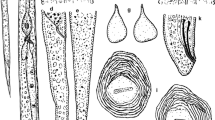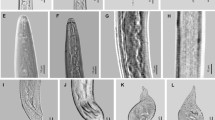Abstract
A root-knot nematode parasitizing rice (Oryza sativa L.) in Santa Catarina state (Brazil) was identified as Meloidogyne oryzae Maas, Sanders and Dede, 1978 using different approaches. The specimens studied from this Brazilian population were compared with the type description of M. oryzae from Suriname, with additional morphological, biochemical and molecular characterization. The female has a longer stylet (15.0 μm) when compared with M. graminicola (11.2 μm) with irregularly shaped knobs, vulva offset and slightly protruding in posterior region. The lip region was distinct from first body annuli, and labial disc and the medial lips form an anchor-shaped structure. Perineal patterns were similar to M. graminicola. The male has a lip region offset and the presence of few short and irregular lines; medial lips divided, not fused with labial disc and stylet (18.2 μm) longer than in M. graminicola (16.8 μm). Second-stage juvenile (J2) tail (75.8 μm) was longer than in M. graminicola (70.9 μm) with a very long narrow hyaline portion (22 μm in M. oryzae and 17.9 μm in M. graminicola). Biochemically, it presented a distinct esterase profile (Est O1=R1), differentiating it from M. graminicola (Est VS1). The number of chromosomes was 3n = 50–56, and in DNA sequences of ITS1–5.8S–ITS2 rRNA the two populations of M. oryzae clustered together with other mitotic parthenogenetic species, differentiating them from M. graminicola with n = 18 chromosomes and clustered with meiotic species. Phylogenetic analysis using neutral markers (AFLP and RAPD) showed that both M. oryzae populations form a coherent, closely related cluster separately from M. graminicola isolates. This study represented the first detection of M. oryzae in Brazil and the second in the world after the species description in 1971.








Similar content being viewed by others
References
Araki, M. (1992). Description of Meloidogyne ichinohei n. sp. (Nematoda:Meloidogynidae) from Iris laevigata in Japan. Japanese Journal of Nematology, 22, 11–20.
Bellafiore, S., Jougla, C., Chapuis, E., Besnard, G., Suong, M., Vu, P. N., De Whale, D., Gantet, P., & Thi, X. N. (2015). Intraspecific variability of the facultative meiotic parthenogenetic root-knot nematode (Meloidogyne graminicola) from rice fields in Vietnam. Comptes Rendus Biologies, 338, 471–483.
Carneiro, R. M. D. G., & Almeida, M. R. A. (2001). Técnica de eletroforese usada no estudo de enzimas dos nematoides de galhas para identificação de espécies. Nematologia Brasileira, 25(1), 35–44.
Carneiro, R. M. D. G., Castagnone-Sereno, P., & Dickson, D. W. (1998). Variability among four populations of Meloidogyne javanica from Brazil. Fundamental and Applied Nematology, 21, 319–326.
Carneiro, R. M. D. G., Almeida, M. R. A., & Quénéhervé, P. (2000). Enzyme phenotypes of Meloidogyne spp. populations. Nematology, 2, 645–654.
Castagnone-Sereno, P., Danchin, E. G., Perfus-Barbeoch, L., & Abad, P. (2013). Diversity and evolution of root-knot nematodes, genus Meloidogyne: new insights from the genomic era. Annual Review of Phytopathology, 51, 203–220.
Coetzee, V. (1956). Meloidogyne acronea, a new species of root-knot nematode. Nature, 4515, 899–900.
De Ley, P., Felix, M. A., Frisse, L. M., Nadler, S. A., Stember, P. W., & Thomas, W. K. (1999). Molecular and morphological characterisation of two reproductive species with mirrorimage anatomy (Nematoda: Cephalobidae). Nematology, 1, 591–612.
De Waele, D., & Elsen, A. (2007). Challenges in tropical plant nematology. Annual Review of Phytopathology, 45, 457–485.
Eisenback, J. D., & Hirschmann, H. (1979). Morphological comparison of second-stage juveniles of six populations of Meloidogyne hapla by SEM. Journal of Nematology, 11, 5–16.
Eisenback, J. D., & Hirschmann, H. (1980). Morphological comparison of Meloidogyne males by scanning electron microscope. Journal of Nematology, 12, 23–32.
Eisenback, J. D., & Triantaphyllou, H. H. (1991). Root-knot nematode: Meloidogyne spp. and races. In W. R. Nickle (Ed.), Manual of agricultural nematology (pp. 191–274). New York: Marcel Dekker.
Eisenback, J. D., Hirschmann, H., & Triantaphyllou, A. C. (1980). Morphological comparison of Meloidogyne female lip region structures, perineal patterns, and stylets. Journal of Nematology, 12, 300–313.
Esbenshade, P. R., & Triantaphyllou, A. C. (1985). Use of enzyme phenotypes for identification of Meloidogyne species. Journal of Nematology, 17, 6–20.
Golden, A. M., & Birchfield, W. (1965). Meloidogyne graminicola (Heteroderidae), a new species of root-knot nematode from grass. Proceedings of the Helminthological Society of Washington, 32, 228–231.
Handoo, Z. A., Huettel, R. N., & Golden, A. M. (1993). Description and SEM observations of Meloidogyne sasseri n. sp. (Nematoda: Meloidogynidae), parasitizing beachgrasses. Journal of Nematology, 25(4), 628.
Huelsenbeck, J. P., Bull, J. J., & Cunningham, C. W. (1996). Combining data in phylogenetic analysis. Trends in Ecology & Evolution, 11(4), 152–158.
Hunt, D. J., & Handoo, Z. A. (2009). Taxonomy, identification and principal species. In R. N. Perry, M. Moens, & J. L. Starr (Eds.), Root-Knot Nematodes (pp. 55–97). Wallingford: CABI.
Jepson, S. B. (1987). Identification of root-knot nematodes (Meloidogyne species). Wallingford: CAB International.
Maas, P. W. T., Sanders, H., & Dede, J. (1978). Meloidogyne oryzae n. sp. (Nematoda, Meloidogynidae) infesting irrigated rice in Surinam (South America). Nematologica, 24, 305–311.
Negretti, R. R., Gomes, C. B., Mattos, V. S., Somavilla, L., Manica-Berto, R., Agostinetto, D., Castagnone-Sereno, P., & Carneiro, R. M. D. G. (2017). Characterisation of a Meloidogyne species complex parasitising rice in southern Brazil. Nematology, 19, 403–412.
Padial, J. M., Miralles, A., De la Riva, I., & Vences, M. (2010). The integrative future of taxonomy. Frontiers in Zoology, 7(1), 16.
Page, S. L. J. (1985). Meloidogyne acronea. In: CIH Descriptions of Plant-parasitic Nematodes, Set 8, No.114. Commonwealth Agricultural Bureaux, Farnham Royal.
Pante, E., Schoelinck, C., & Puillandre, N. (2015). From integrative taxonomy to species description: one step beyond. Systematic Biology, 64, 152–160.
Plantard, O., Valette, S., & Gross, M. F. (2007). The root-knot nematode producing galls on Spartina alterniflora belongs to the genus Meloidogyne: Rejection of Hypsoperine and Spartonema spp. Journal of Nematology, 39, 127–132.
Randig, O., Bongiovanni, M., Carneiro, R. M. D. G. & Castagnone-Sereno, P. (2002). Genetic diversity of root-knot nematodes from Brazil and development of SCAR markers specific for the coffee-damaging species. Genome, 45, 862–870.
Saitou, N., & Nei, M. (1987). The Neighbor-Joining method, a new method for reconstructing phylogenetic trees. Molecular Biology and Evolution, 4, 406–425.
Schmitz, B., Burgermeister, W., & Braasch, H. (1998). Molecular genetic classification of Central European Meloidogyne chitwoodi and M. fallax populations. Nachrichtenblatt des Deutschen Pflanzenschutzdienstes, 50, 310–317.
Siddiqi, M. R. (2000). Tylenchida: parasites of plants and insects (2nd ed.). Wallingford: CABI.
Suazo, A. & Hall, H. G. (1999). Modification of the AFLP protocol applied to honey bee (Apis mellifera L.) DNA. Biotechniques, 26(4), 704–705.
Subbotin, S., Waeyenberge, A.L. & Moens, M. (2000). Identification of cyst forming nematodes of the genus Heterodera (Nematoda: Heteroderidae) based on the ribosomal DNA RFLPs. Nematology, 2, 153–164.
Swofford, D. L. (2002). PAUP*: phylogenetic analysis using parsimony (*and other methods). Version 4b10. Massachusetts: Sinauer Associates.
Tamura, K., Peterson, D., Peterson, N., Stecher, G., Nei, M., & Kumar, S. (2011). MEGA5: molecular evolutionary genetics analysis using maximum likelihood, evolutionary distance, and maximum parsimony methods. Molecular Biology and Evolution, 28, 2731–2739.
Taylor, D. P., & Netscher, C. (1974). An improved technique for preparing perineal patterns of Meloidogyne spp. Nematologica, 20, 268–269.
Tigano, M. S., Carneiro, R. M. D. G., Jeyaprakash, A., Dickson, D. W., & Adams, B. J. (2005). Phylogeny of Meloidogyne spp. based on 18S rDNA and the intergenic region of mitochondrial DNA sequences. Nematology, 7(6), 851–862.
Triantaphyllou, A. C. (1985a). Cytogenetics, cytotaxonomy and phylogeny of root-knot nematodes. In J. N. Sasser & C. C. Carter (Eds.), An Advanced Treatise on Meloidogyne. Vol. I. Biology and Control (pp. 113–126). Raleigh: North Carolina State University Graphics.
Triantaphyllou, A. C. (1985b). Cytological methods for the study of oogenesis and reproduction of root-knot nematodes. In K. R. Barker, C. C. Carter, & J. N. Sasser (Eds.), An advanced treatise on Meloidogyne: Methodology (Vol. 2, pp. 107–114). Raleigh: North Carolina State University Graphics.
Acknowledgements
This work was supported by Conselho Nacional de Desenvolvimento Científico e Tecnológico – CNPq (PROTAX/CNPq Grant # 562346/2010-4), EMBRAPA—Recursos Genéticos e Biotecnologia and Fundação de Apoio à Pesquisa do Distrito Federal (FAP-DF). V.S. Mattos, G.M. Gomez and R.M.D.G. Carneiro thank CNPq for their scholarships.
Author information
Authors and Affiliations
Corresponding author
Rights and permissions
About this article
Cite this article
da Mattos, V.S., Cares, J.E., Gomes, C.B. et al. Integrative Taxonomy of Meloidogyne oryzae (Nematoda: Meloidogyninae) parasitizing rice crops in Southern Brazil. Eur J Plant Pathol 151, 649–662 (2018). https://doi.org/10.1007/s10658-017-1400-9
Accepted:
Published:
Issue Date:
DOI: https://doi.org/10.1007/s10658-017-1400-9




